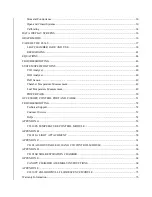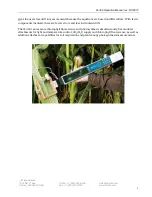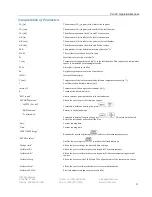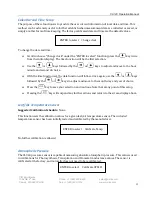
CI-340 Operation Manual rev. 6/7/2017
CID Bio-Science
1554 NE 3
rd
Ave
Camas, WA 98607, USA
Phone: +1 (360) 833-8835
Fax: +1 (360) 833-1914
[email protected]
www.cid-inc.com
2
Dispersive and Non-Dispersive IRGA
Infrared gas analyzers can be either dispersive or non-dispersive. Dispersive infrared analyzers
sequentially apply monochromatic radiation, which determines the concentration of various gas
species in a complex mixture of gases. In contrast, non-dispersive analyzers assay the concentration of
a particular species of gas.
Non-dispersive analyzers are commonly used for photosynthesis measurements and function by using
broad-spectrum infrared radiation, made selective for CO
2
by the use of filters in the optical path.
Typically, detectors designed for CO
2
exhibit cross-sensitivity to the absorption spectrum of water
vapor. Although filters can minimize this interference, it is necessary to correct the apparent CO
2
concentration if there is significant water vapor in the airstream at the intake of the analyzer.
Alternatively, water vapor may be condensed or chemically removed just before the airstream enters
the analyzer.
Photosynthesis Measurement Using IRGA
Photosynthesis is the process by which higher plants transform sunlight into chemical energy. During
this process, plants produce carbohydrates from carbon dioxide and water. This occurs in the presence
of chlorophyll by converting light energy to chemical energy. Measuring photosynthesis is important in
comparing and understanding productivity and biomass accumulation at the leaf, plant and community
(canopy) level as well as in quantifying plant response to environmental stresses and variables, such as
light and temperature.
Most photosynthesis meters are based on the concept of gas exchange on the leaf and typically measure
carbon dioxide and water vapor concentrations. The uptake of CO
2
and the release of H
2
O both use the
stomata as their pathway; therefore most photosynthesis measurements include an estimation of
photosynthetic rate (CO
2
uptake) and transpiration rate, as well as stomatal conductance.
Carbon dioxide uptake is measured using an IRGA by comparing the CO
2
concentration of gas passing
into a chamber surrounding a leaf/plant and the CO
2
leaving the chamber. The CO
2
concentration of the
gas initially passing into the chamber is measured, and then the gas is pumped through the chamber at
a known flow rate. The concentration in the effluent gas from the chamber is measured using the IRGA
and the difference between this and the input gas is used to measure photosynthetic rate (or
respiration rate if a greater CO
2
concentration is measured in the effluent gas stream).
Net photosynthesis (Pn) can be determined using the IRGA measurements of the change in CO
2
. IRGAs
can also be used to measure environmental responses and photosynthetic capacity and determine
other parameters, such as instantaneous gas flux measurements, gas exchange over time (such as for
diurnal cycles), photosynthesis-light response curves, photosynthesis-temperature response curves
and photosynthesis-CO
2
response curves.
Содержание CI-340
Страница 3: ......






































